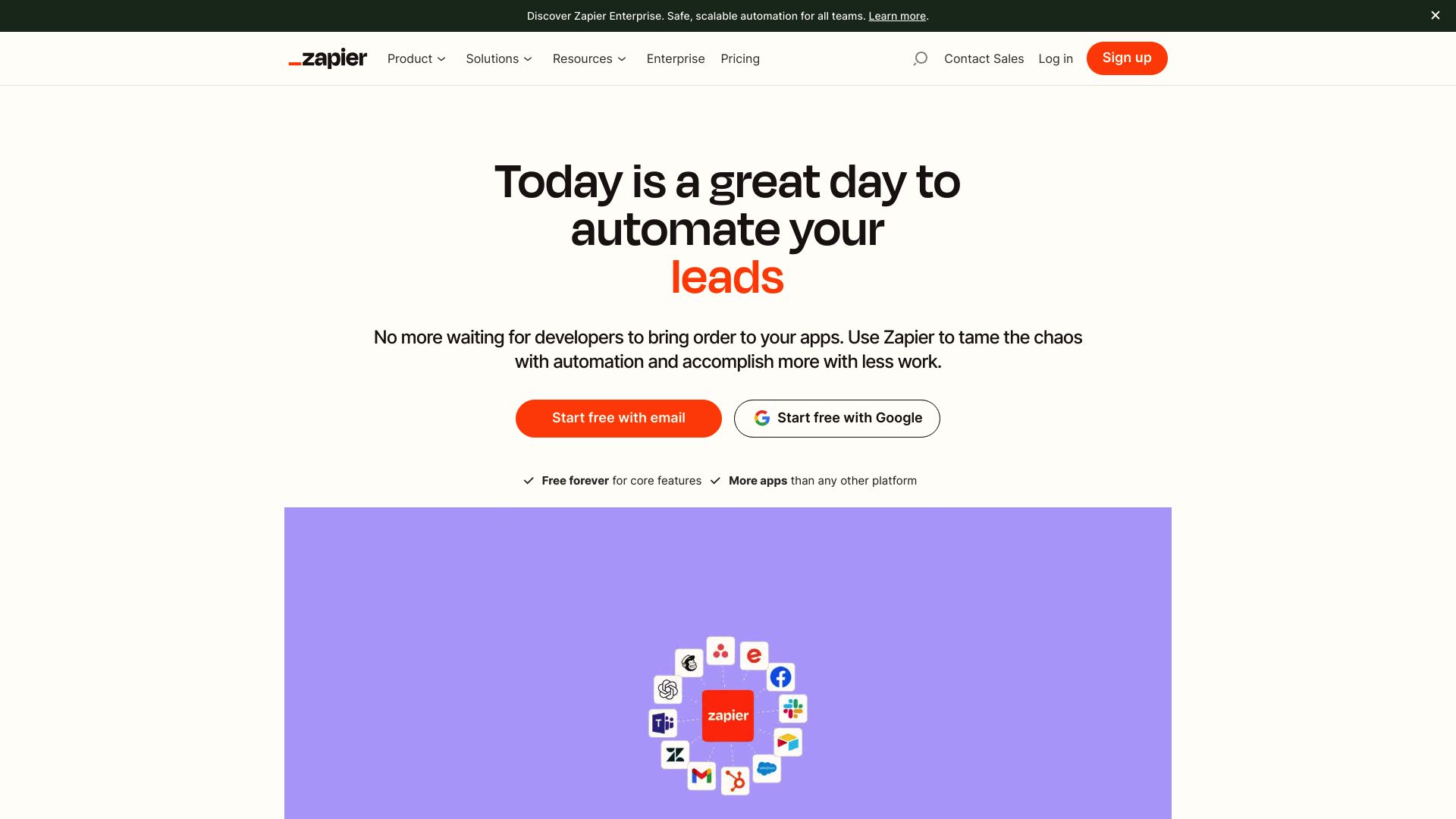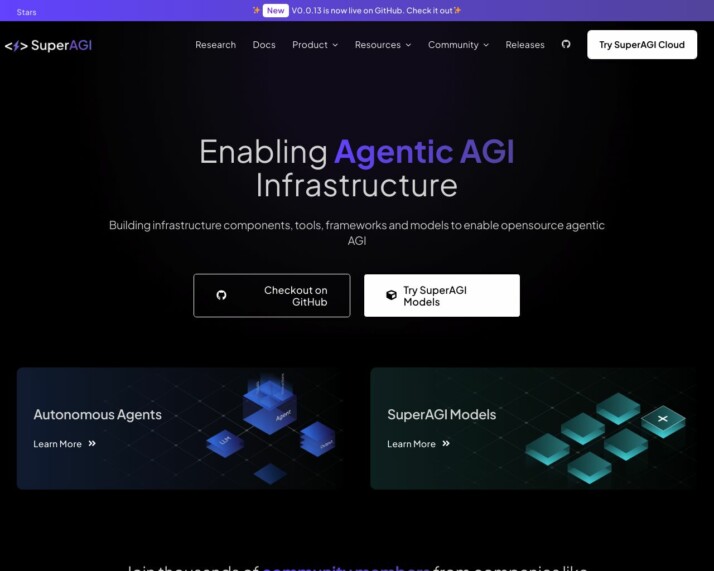Zapier vs. SuperAGI: Comparing AI Automation Powerhouses
AI-driven automation tools revolutionize how businesses operate, connecting apps and streamlining workflows. This review compares Zapier vs. SuperAGI, and SmythOS, three platforms at the forefront of this technological shift. Zapier excels in no-code integrations, SuperAGI offers an open-source framework for AI agent development, while SmythOS combines user-friendly automation with advanced AI capabilities.
We’ll explore each platform’s strengths, limitations, and ideal use cases, helping you choose the right tool for your automation needs. Whether you’re a developer seeking powerful AI frameworks, a business leader looking to optimize operations, or a non-technical user aiming to boost productivity, this comparison provides insights to guide your decision-making process.
Zapier Overview
Zapier empowers users to connect and automate workflows across thousands of apps without coding. The platform’s visual interface allows anyone to create multi-step “Zaps” that trigger actions between different web services.


At its core, Zapier serves as an integration hub for over 6,000 apps, from major platforms like Google and Salesforce to niche tools. Users leverage pre-built templates or craft custom workflows to automate repetitive tasks, sync data, and streamline processes. The platform caters to individuals, small businesses, and enterprises seeking efficiency gains through automation.
Zapier empowers users to connect and automate workflows across thousands of apps without coding. The platform’s visual interface allows anyone to create multi-step “Zaps”…
Zapier’s strength lies in its accessibility. The visual Zap editor enables users to build complex integrations through an intuitive drag-and-drop interface. For developers, Zapier offers CLI tools and JavaScript-based custom coding options to extend functionality. This flexibility makes it suitable for both non-technical users and seasoned programmers.
While Zapier excels at app integration, it lacks native AI agent capabilities. The platform focuses on rule-based automation rather than intelligent, autonomous decision-making. Users looking for advanced AI features or natural language processing may find Zapier’s offerings limited in this regard.
Scalability and reliability stand out as key advantages. Zapier’s infrastructure handles millions of automated tasks daily, ensuring consistent performance for businesses of all sizes. The platform also prioritizes security, implementing encryption and OAuth support to protect sensitive data flowing through integrations.
SuperAGI Overview
SuperAGI offers an open-source autonomous AI agent framework, empowering developers to build, manage, and deploy intelligent systems. The platform stands out with its dev-first approach, enabling the creation of agents capable of executing diverse tasks and improving their performance over time.


At the core of SuperAGI’s offerings is SuperCoder 2.0, a powerful tool leveraging Large Language Models (LLMs) and Large Action Models (LAMs) fine-tuned for Python code generation. This technology facilitates highly accurate and efficient autonomous software development, setting SuperAGI apart in the AI agent landscape.
SuperAGI offers an open-source autonomous AI agent framework, empowering developers to build, manage, and deploy intelligent systems.
SuperAGI distinguishes itself through several key features. The platform supports a wide range of tool integrations out of the box, including Slack, email, Google Search, GitHub, Zapier, and Instagram. This extensibility allows agents to seamlessly perform diverse tasks. SuperAGI also provides a user-friendly graphical interface, simplifying agent management and interaction. The framework’s ability to run multiple agents concurrently enhances efficiency and productivity. Additionally, SuperAGI’s Docker-based installation streamlines the setup process, avoiding common Python versioning and module dependency issues.
SuperAGI distinguishes itself through several key features… including Slack, email, Google Search, GitHub, Zapier, and Instagram.
SuperAGI’s unique value proposition lies in its combination of software guardrails specific to development frameworks with Generally Intelligent Developer Agents. This approach enables the creation of complex real-world software systems. The platform ensures top-tier security and compliance while integrating deeply with existing developer tools such as Jira, GitHub, and Jenkins. SuperAGI reimagines version control and issue tracking for an autonomous software development paradigm.
While SuperAGI offers impressive capabilities, users should consider potential limitations. The open-source nature of the platform may require more technical expertise for customization and deployment compared to some commercial alternatives. Additionally, the rapid evolution of AI technologies means users must stay updated with the latest developments to fully leverage SuperAGI’s capabilities.
Feature Comparison
Zapier and SuperAGI offer distinct approaches to automation and AI development. Zapier excels in app integration and workflow automation, providing a user-friendly platform for connecting thousands of web services. Its visual interface enables users to create multi-step workflows without coding. However, Zapier lacks native AI agent capabilities and focuses primarily on rule-based automation.
SuperAGI, as an open-source autonomous AI agent framework, fills gaps in Zapier’s offerings. It provides tools for building intelligent systems capable of executing diverse tasks and improving over time. SuperAGI’s SuperCoder 2.0 leverages advanced language models for code generation, enabling highly efficient autonomous software development. Unlike Zapier, SuperAGI supports the creation of AI agents with problem-solving capabilities and the ability to operate autonomously.
In terms of security and core components, SuperAGI offers more robust features. While both platforms support OAuth and data encryption, SuperAGI provides additional layers of security through constrained alignment and customizable AI behaviors. SuperAGI’s framework also includes advanced components like foundation AIs and Huggingface integration, which are absent in Zapier’s offering. These features give SuperAGI an edge in developing sophisticated AI solutions that go beyond simple automation tasks.
Feature Comparison Table
| Zapier | SuperAGI | SmythOS | |
|---|---|---|---|
| CORE FEATURES | |||
| AI Agents | ❌ | ✅ | ✅ |
| Hosted Agents (Dev, Production) | ❌ | ✅ | ✅ |
| Visual Builder | ✅ | ❌ | ✅ |
| No-Code Options | ✅ | ❌ | ✅ |
| Memory & Context | ❌ | ✅ | ✅ |
| Autonomous Agents | ❌ | ✅ | ✅ |
| Explainability & Transparency | ❌ | ✅ | ✅ |
| Multimodal | ❌ | ✅ | ✅ |
| Problem-Solving Capabilities | ❌ | ✅ | ✅ |
| Multi-Agent Collaboration | ❌ | ✅ | ✅ |
| Human-AI Interaction | ❌ | ✅ | ✅ |
| Agent Work Scheduler | ❌ | ✅ | ✅ |
| SECURITY | |||
| Constrained Alignment | ❌ | ✅ | ✅ |
| IP Control | ❌ | ❌ | ✅ |
| COMPONENTS | |||
| Foundation AIs | ❌ | ✅ | ✅ |
| Huggingface AIs | ❌ | ✅ | ✅ |
| Classifiers | ❌ | ✅ | ✅ |
| Logic | ❌ | ✅ | ✅ |
| Data Lakes | ❌ | ❌ | ✅ |
| DEPLOYMENT OPTIONS (EMBODIMENTS) | |||
| Staging Domains | ✅ | ❌ | ✅ |
| Deploy as Site Chat | ❌ | ✅ | ✅ |
| Deploy as Scheduled Agent | ❌ | ✅ | ✅ |
| Deploy as GPT | ❌ | ✅ | ✅ |
| DATA LAKE SUPPORT | |||
| Hosted Vector Database | ❌ | ✅ | ✅ |
| Sitemap Crawler | ❌ | ❌ | ✅ |
| YouTube Transcript Crawler | ❌ | ❌ | ✅ |
| URL Crawler | ❌ | ✅ | ✅ |
| PDF Support | ❌ | ✅ | ✅ |
| Word File Support | ❌ | ✅ | ✅ |
| TXT File Support | ❌ | ✅ | ✅ |
Best Alternative to Zapier and SuperAGI
SmythOS emerges as the superior alternative to Zapier and SuperAGI, offering a comprehensive AI agent automation platform that combines the best of both worlds. Our solution bridges the gap between simple workflow automation and advanced AI development, providing a versatile toolset for businesses of all sizes.
While Zapier excels at connecting web services, it lacks native AI capabilities. SuperAGI offers open-source AI agent development but requires significant technical expertise. SmythOS delivers a no-code visual builder that empowers users to create sophisticated AI agents without programming knowledge. This approach democratizes AI development, making it accessible to a wider audience.
SmythOS delivers a no-code visual builder that empowers users to create sophisticated AI agents without programming knowledge.
SmythOS outshines competitors with its extensive feature set. We offer hosted agents for both development and production environments, ensuring seamless deployment across various stages. Our platform supports multimodal interactions, enabling agents to process and respond to diverse data types. SmythOS also facilitates multi-agent collaboration, allowing teams of AI agents to work together on complex tasks.
Security and scalability set SmythOS apart. We implement robust data encryption, OAuth integration, and IP control features to protect sensitive information. Our platform scales effortlessly to meet growing demands, supporting enterprise-level deployments without compromising performance. SmythOS also provides a hosted vector database and supports various data formats, enhancing data management capabilities.
With its drag-and-drop interface, pre-built API integrations, and support for multiple AI models, SmythOS streamlines the creation and deployment of AI agents. Users can effortlessly design workflows connecting to various data sources, APIs, and AI models, making advanced AI functionalities both accessible and powerful. By choosing SmythOS, businesses gain a versatile AI operating system that enables them to create, deploy, and manage AI agents efficiently, driving innovation and automation across industries.
Conclusion
Zapier and SuperAGI offer distinct approaches to automation and AI development, each with unique strengths. Zapier excels in connecting apps and automating workflows without coding, making it ideal for businesses seeking straightforward integration solutions. SuperAGI, as an open-source AI agent framework, provides powerful tools for building intelligent systems capable of complex tasks and autonomous decision-making.
While both platforms have their merits, SmythOS emerges as the superior choice, combining the best of both worlds and offering additional cutting-edge features. We provide a user-friendly drag-and-drop interface similar to Zapier, making it accessible to non-technical users. At the same time, our platform supports advanced AI capabilities akin to SuperAGI, allowing for the creation of sophisticated, autonomous agents.
SmythOS stands out with its extensive integration ecosystem, supporting over 300,000 integrations and a wide range of AI models. Our ’Create Once, Deploy Anywhere’ approach ensures maximum flexibility, allowing users to deploy AI agents across various platforms and services effortlessly. This versatility, combined with our robust security features and scalability, makes SmythOS an ideal choice for businesses of all sizes looking to harness the power of AI.
We invite you to explore our diverse range of AI-powered agent templates and discover the future of AI integrations in one platform. Ready to transform your workflow with intelligent agents? Get started with SmythOS and experience the next generation of AI automation. For those seeking in-depth information, our comprehensive documentation provides all the insights you need to make an informed decision and unlock AI-powered success.
Last updated:
Disclaimer: The information presented in this article is for general informational purposes only and is provided as is. While we strive to keep the content up-to-date and accurate, we make no representations or warranties of any kind, express or implied, about the completeness, accuracy, reliability, suitability, or availability of the information contained in this article.
Any reliance you place on such information is strictly at your own risk. We reserve the right to make additions, deletions, or modifications to the contents of this article at any time without prior notice.
In no event will we be liable for any loss or damage including without limitation, indirect or consequential loss or damage, or any loss or damage whatsoever arising from loss of data, profits, or any other loss not specified herein arising out of, or in connection with, the use of this article.
Despite our best efforts, this article may contain oversights, errors, or omissions. If you notice any inaccuracies or have concerns about the content, please report them through our content feedback form. Your input helps us maintain the quality and reliability of our information.
